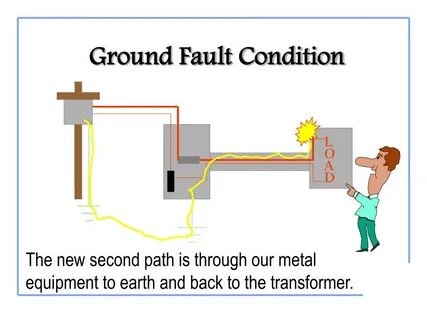Find out more about ground fault, the occurrence of ground fault, ground fault protection device types as well as ground fault safety measures. Comprehensive book on Electrical ground fault protection systems and prevention techniques.
Understanding Ground Faults: The Foundation of Electrical Safety
Ground fault is one of the most serious electrical safety risks in the residential and commercial applicational settings. In its essence, a ground fault is an event when electrical current follows an alternative route, to the ground where the results may present a potentially hazardous situation leading to electric shock, fires or destruction of equipment.

National Electrical Code (NFPA 70) An electrical current (ground fault) occurs when there is an unintended, electrically conductive interconnection involving an ungrounded conductor of an electric circuit and metallic enclosures, metallic raceways, metallic equipment or earth, or the normally non-current-carrying conductors of an electric circuit. Based on this definition is the fact that ground faults are involuntary and they can pose dangerous conditions.
What Causes Ground Faults to Occur?
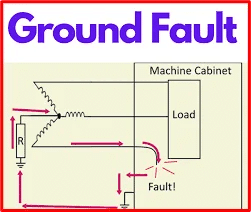
Ground faults do not occur randomly, they are founded on certain conditions and wearing of electrical systems. These causes are imperative aspects of prevention and safety.
Primary Causes of Ground Faults
There can be ground faults in damaged insulation, faulty wiring or equipment malfunction. Most common causes are:
Insulation Breakdown: With age, or heat, moisture or physical damage over time, aged electrical insulation can fail in well over half of all failures in the electrical industry. Fault paths may occur when just any energized conductors contact with grounded ones; the failure of insulation may cause that contact.
Moisture Intrusion: There are dangerous combinations of water and electricity. Water may enter electrical enclosures, induce conductive surfaces between live conductors and the ground. It is mostly observed in exterior set-ups, basements and highly humid zones.
Physical Damage: physical damage of electrical installations due to the construction process, rodent damage or accidental collision can expose conductors and lead to a ground fault situation.
Equipment Deterioration: All electrical equipment has a tendency to age and part failure develops internal ground faults, which are not immediately noticeable.
Environmental Factors
Ground fault likelihood is influenced importantly by environmental conditions. Abrasion can be enhanced by corrosive atmospheres, large and small variations in temperatures and vibration. The risk of accidents of ground faults is high in industrial installations, marine working, and other places where chemicals are involved.
Types of Ground Fault Protection Systems
Contemporary electrical installations have several types of ground fault protection used in a specific application and with a certain degree of protection.
Ground Fault Circuit Interrupters (GFCIs)
The GFCI has a fast enough trip rating to eliminate an electrical incident. This will occur when the defective tool is plugged in properly installed and well maintained. GFCIs protect an individual by tapping the current and detect any imbalance of as little as 4-6 milliamperes.
GFCIs are in effect due to the comparison of current between the hot conductors and the neutral conductors. When there is more than the currents that exceed the trip threshold of the device, it means that there is a flow of current through an undesired pathway which may be through a person, or to ground. The GFCI counters this by cutting off the circuit in milliseconds.
Ground Fault Protection Equipment (GFPE)
As people are guarded by the GFCIs, the electrical equipment and property are guarded by the GFPE systems. Such systems usually have larger current ratings (usually 30 milliamperes or more) and the aim is to detect ground faults that may lead to equipment damage or fires.
Even on commercial and industrial installations a use and obligation of GFPE systems is common, especially on services that are 1000 amperes and above. They give vital safety to the costly electrical devices and aid to obstruct the fire electrical.
Arc Fault Circuit Interrupters (AFCIs)
Although AFCIs were mainly made as an arc fault protection device, they also offer a certain degree of ground fault protection. Such devices identify hazardous arcing modes which may happen when polished or degraded conductors establish periodic grounding to responsive surfaces.
How Ground Fault Protection Works
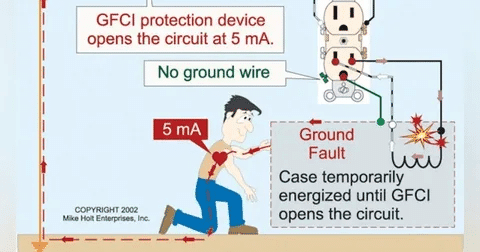
Ground fault protection Ground fault protection is an important safety feature that resorts to protecting against abnormal or excessive currents and avoiding dangerous conditions by diverting the current to the ground. The process of protection has some important components that interact.
Detection Mechanisms
Ground fault protection devices incorporate advanced technology to control the electrical systems on a continuous basis. Current transformer or other sensing equipment compares the current carried by conductors in circuit, seeking an absence of balance that signifies ground faults.
Response Times
Ground fault protective devices ought to co-ordinate with other protective equipment such as circuit breakers and fuse. This coordination is done properly so that the best suited device comes in first and this would cause the least disturbance to the system but it would be the best solution on safety.
Coordination with Other Protection Systems
Early detection of ground fault symptoms will avoid severe safety risks and damages to the equipment. There are a number of warning indicators that demonstrate the possibility of ground fault.
Common Signs and Symptoms of Ground Faults
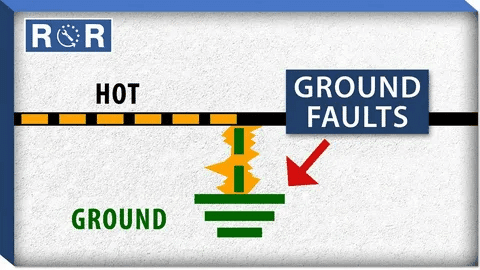
Ground fault protective devices ought to co-ordinate with other protective equipment such as circuit breakers and fuse. This coordination is done properly so that the best suited device comes in first and this would cause the least disturbance to the system but it would be the best solution on safety.
Electrical Symptoms
Frequent Circuit Breaker Trips: Frequent tripping of circuit breakers, particularly of the GFCIs, is usually the signal of the ground fault conditions. Trips that occur intermittently are of finding that particular case since they are caused by temporary conditions but frequent trips should be investigated.
Abnormal electricity: If Lights are continuously flickering, equipment behaving unpredictably or electrical apparatus feels warm under conditions when this is not supposed to be the case then this is a sign of a ground fault problem.
Electrical Shock: Any shock through any appliances, tools or even surface of the buildings portrays severe ground fault and has to be attended to immediately.
Physical Indicators
Burn Marks or Discoloration: Scorch marks on the side of electrical outlets, panels, or equipment is an indication of arcing or high-resistance ground faults which are able to produce heat.
Burning or Ozone smells: Burning plastic or other unusual burning smells or ozone related smells may be evidence of ground fault condition with consequential over heat.
Corrosion: It is possible there is too much corrosion on-board electrical components and this could mean a moisture has entered the system and created a ground fault scenario.
Installation and Maintenance Best Practices
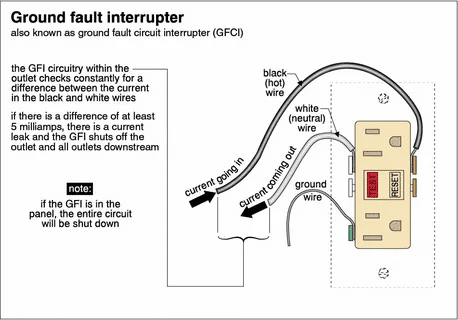
Ground fault protection uses: Proper installation and subsequent maintenance are crucial to ground fault protection. Such practices make systems to be reliable where they are most required.
Installation Standards
Ground fault protection devices need to be installed as per manufacturers specification and as per any electrical code. Important installation factors are:
Correct Wiring: Connections should be sound and well torqued. Loose connections may cause resistance which influences the operation in the device.
Environmental issues: Devices have to be rated according to the environment in which they are installed. Outdoor installations will be exposed to weather and must be weather proofed whereas industrial applications might require equipment that is constructed to withstand severe conditions.
Load Compatibility: Load requirements: Protection devices need to be applicable to the loads being protected. Certain loads such as motors, or electronic equipment may need special considerations.
Maintenance Requirements
Delta-Delta circuit in the ground fault protection systems makes sure that it becomes operative over the service life of the systems by regular maintenance. Maintenance functions:
Monthly Testing: most ground fault protection devices have test buttons that are expected to be pushed/tapped on a monthly basis to identify that they are performing as they should.
Visual Inspection: Through consistent visual checks it is possible to detect physical damage, corrosion or any other situation that may have impact to the performance of the device in use.
Professional Inspection: With the assistance of certified electrician annual professional inspections can be done to detect issues that might have become safety hazards.
Ground Fault Protection in Different Applications
Depending on the application and condition, the ground fault protection requirements are substantially different. Differentiation of these differences is important toward effective protection.
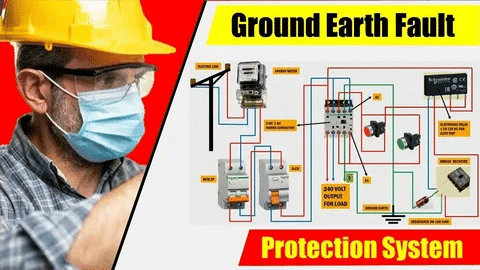
Residential Applications
Residential ground fault protection is dedicated more towards personal safety. Some of the material areas that GFCI should be used on are:
Bathrooms and Kitchens: These wet areas are subject to GFCI protection because there is a higher potential of ground faults under the presence of water.
Outdoor Circuits: All outdoor receptacles should be GFCI-protected to help deal with the moisture and weather exposure dangers.
Garages and Basements These are locations with a more concentrated moisture and greater chances of ground faults.
Commercial and Industrial Applications
The ground fault protection in commercial and industrial installations is more complicated. These areas usually go hand in hand with personnel (GFCIs) as well as equipment (GFPE) protection systems.
Manufacturing Facilities: The Indian processes involved in manufacturing can imply subjecting electrical systems to severe conditions, so that any ground fault protection system should be very solid.
Data Centers: The sensitive electronic equipments here need special ground fault protection to protect those equipments against damage and assuring reliability of the system.
Safety Considerations and Best Practices
When it comes to ground fault safety, the measures do not only involve installation of protective gadgets. A complete safety involves getting to know and being concerned about a number of safety levels.
Personal Safety Measures
Use of Proper Tools: Proper selection of tools- tools that have proper insulation and protection rating will minimize the risks of ground fault.
Workplace Awareness: Although ground fault hazards might not be obvious, being familiar with them makes workers aware of hazardous conditions and lead them to prevent them.
Emergency Procedures: How to react to electrical emergencies Nobody wants to get injured or cause serious damage, so knowing how to react can help a lot.
System Design Considerations
Redundancy: Ground fault protection Critical systems can also be over-protected to keep them operating.
Selectivity: Protection systems must be developed with such a capability that only the circuit involved is opened to limit the disturbance of the system.
Documentation: Also, the adequate documentation of the protection systems will be helpful in maintenance and solving problems.
Industry Standards and Regulations
There are a number of standards and regulations that guide the ground fault protection and they all maintain the safety levels across the applications.
National Electrical Code (NEC)
The NEC has very detailed ground fault protection requirements in different applications. These are needs, which are changing with the development of technology, and the discovery of new risks.
International Standards
Such international standards as IEC 61008 and IEC 61009 offer international guidelines in the design and functionality of ground fault protection devices worldwide.
Industry-Specific Requirements
Ground fault protection requirements vary among the different industries depending on the industry-related hazards and risks. Enhanced applications of healthcare, marine, and hazardous location environments usually exist.
Technological Advances in Ground Fault Protection
Ground fault protection technology keeps improving with offering a better security and performance.
Smart Protection Devices
The contemporary ground fault protection devices are smart devices with additional features of monitoring, problem diagnostics, and communications.
Enhanced Sensitivity
New equipment induced higher sensitivity and discrimination rates that incapacitated nuisance trips with safety uncompromised.
Integration with Building Systems
Ground fault protection systems are less and less keeping apart of building automation systems and energy management systems that offers overall electrical systems protection.
Troubleshooting Ground Fault Issues

Systematic troubleshooting allows solving problems safely and quickly when ground faults take place.
Initial Assessment
Safety First: Always de-energize and lock edit the injured circuit before looking into the discovery of ground faults.
Systematic Approach: Employ logical method to locate and provide a cause of a fault.
Documentation: Keep records of discoveries so as to facilitate any future troubleshooting and maintenance operations.
Common Troubleshooting Techniques
Insulation Testing: Insulation failures and possible points of ground-fault can be detected by a Megohmmeter testing.
Visual Inspection: Close inspection with the line of sight may help in exposing the physical damage or wear out that results in the ground faults.
Load Analysis: Because the connected loads can be a source of ground fault, it is important to understand the loads.
The Role of Professional Installation and Service
Although knowledge of ground fault protection is useful, professional installation and service can be very important in terms of keeping safe and meeting code requirements.
Qualified Electricians
Licensed electricians are those people, trained and experienced enough to properly install, test, and maintain ground fault protection systems.
Code Compliance
Professional installation guarantees that it would adhere to the relevant electrical codes and standards, lowering liabilities and guaranteeing safety.
System Integration
Professionals should be in a position of appropriately combining ground fault protection and other electrical safety systems to provide full protection.
Conclusion
Ground fault protection is an element of electrical safety that is important and that ensures the safety of people and property against the dangerous consequences of electrical faults. The concept of ground faults, their causes, and the operational principle of protection systems are the essential ones that everyone working with electrical systems should be familiar with. Ranging in complexity from household GFCI outlets to full scale industrial ground fault protection, GFCI device offers life saving protection when installed and properly maintained. Routine testing and maintenance coupled with periodic inspection by qualified personnel ascertain that these systems are potent throughout their lifetime and will protect and afford safety as it is intended.

